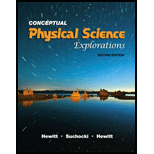
Do metals more readily gain or lose electrons?
Whether the metals more readily gain or lose electrons.
Answer to Problem 11RQ
Metals more readily lose electrons.
Explanation of Solution
All the elements are mainly arranged together inperiodic table. The elements existing in periodic table are broadly classified into two main types; that is metals and non-metals.
Metals are placed towards the left side in periodic table whereas non-metals are placed towards the right side in periodic table. Since metals are placed towardsleft side and contain lesser number of valence electrons. Metals basically possess highly electropositive characteristics due to which metals tend to furnish (lose) electrons.
Thus, metals tend to furnish their valence electrons to get their stability and forms positive ions.
Conclusion:
Therefore, metals more readily lose electrons.
Chapter 18 Solutions
Conceptual Physical Science Explorations
Additional Science Textbook Solutions
Physics for Scientists and Engineers: A Strategic Approach with Modern Physics (4th Edition)
The Cosmic Perspective Fundamentals (2nd Edition)
Applied Physics (11th Edition)
Cosmic Perspective Fundamentals
Introduction to Electrodynamics
Essential University Physics (3rd Edition)
 College PhysicsPhysicsISBN:9781305952300Author:Raymond A. Serway, Chris VuillePublisher:Cengage Learning
College PhysicsPhysicsISBN:9781305952300Author:Raymond A. Serway, Chris VuillePublisher:Cengage Learning University Physics (14th Edition)PhysicsISBN:9780133969290Author:Hugh D. Young, Roger A. FreedmanPublisher:PEARSON
University Physics (14th Edition)PhysicsISBN:9780133969290Author:Hugh D. Young, Roger A. FreedmanPublisher:PEARSON Introduction To Quantum MechanicsPhysicsISBN:9781107189638Author:Griffiths, David J., Schroeter, Darrell F.Publisher:Cambridge University Press
Introduction To Quantum MechanicsPhysicsISBN:9781107189638Author:Griffiths, David J., Schroeter, Darrell F.Publisher:Cambridge University Press Physics for Scientists and EngineersPhysicsISBN:9781337553278Author:Raymond A. Serway, John W. JewettPublisher:Cengage Learning
Physics for Scientists and EngineersPhysicsISBN:9781337553278Author:Raymond A. Serway, John W. JewettPublisher:Cengage Learning Lecture- Tutorials for Introductory AstronomyPhysicsISBN:9780321820464Author:Edward E. Prather, Tim P. Slater, Jeff P. Adams, Gina BrissendenPublisher:Addison-Wesley
Lecture- Tutorials for Introductory AstronomyPhysicsISBN:9780321820464Author:Edward E. Prather, Tim P. Slater, Jeff P. Adams, Gina BrissendenPublisher:Addison-Wesley College Physics: A Strategic Approach (4th Editio...PhysicsISBN:9780134609034Author:Randall D. Knight (Professor Emeritus), Brian Jones, Stuart FieldPublisher:PEARSON
College Physics: A Strategic Approach (4th Editio...PhysicsISBN:9780134609034Author:Randall D. Knight (Professor Emeritus), Brian Jones, Stuart FieldPublisher:PEARSON





